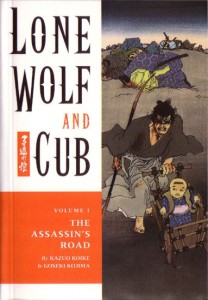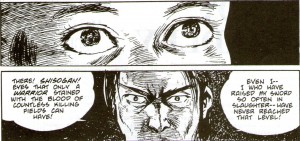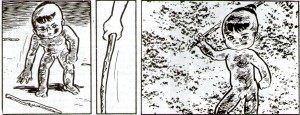Overview: Lone Wolf and Cub – the First eleven issues
by Martin Skidmore 10-Oct-11
Lone Wolf and Cub, or Kozure Okami in Japanese, is one of the big success stories of manga. I intend to try to explain why I think this is one of the finest few comic series I’ve ever seen.

Frank Miller's cover for issue 1 of the Dark Horse collection of Lone Wolf and Cub. He drew this originally for issue 7 of the First run.
[Martin Skidmore’s enormous enthusiasm for Japanese manga, which combines two of Martin’s passions, comics and Japanese art, was obvious to anyone who knew him, and is, of course, reflected in the Magnificent Manga series he wrote for FA Online. In FA 104 (July 1988), in the early throes of this love affair with manga, he wrote his first reaction to the series Lone Wolf and Cub. Over the subsequent thirteen years, Martin wrote about Lone Wolf and Cub a lot: in Part 2 of Magnificent Manga, for his Japanese Arts website (where he also took another look at ‘The Gateless Barrier’, the story from First’s issue 3 discussed below), and as part of his ‘Comics: A Beginner’s Guide’ article on Kazuo Koike and Goseki Kojima, for Freaky Trigger. Though this original piece goes over some of the same ground as his later treatments, we think it is worth reproducing, if only for the detailed examination of First’s issue 11. As before, the captions to the illustrations (except for the Miller cover) are Martin’s own. – TK]
At last, in the last year or two, a few Japanese comics have made it into the English language. Maybe you’ve read Marvel’s Akira, or one of Eclipse’s titles – Mai, Kamui or Area 88 – or even the subject of this article. If not, you really should try one or two of them. Still, these few are not even scratching the tip of the colossal iceberg. The Japanese comic market is mind-numbingly different from what we’re used to: several weeklies sell in the millions, even comics bought only by adults can sell over a million. They generally run to well over 300 pages for around 50p. You can find comic vending machines. Creators are TV celebrities, and comic creators regularly appear among Japan’s top earners.
Lone Wolf and Cub, or Kozure Okami in Japanese, is one of the big success stories. It ran in the adult weekly Manga Action between 1970 and 1976, amassing over 9,000 pages of story, spawning five records, four plays, a lengthy TV series and six feature films. It has been cited as a major inspiration by movie directors John Milius and John Carpenter and, of course, American comics megastar Frank Miller; some people have even accused him of ripping it off for his Ronin, a grossly unfair allegation, though careful reading of Ronin does reveal a number of influences. As with artists like Eisner, Miller has clearly seen Lone Wolf and Cub’s artist, Goseki Kojima, as another master from whom there is much he can learn. In this, once again, Miller was a serious student, not a plagiarist.
So, with a little interest developing in Japanese comics, largely due to Frederik Schodt’s magnificent, invaluable Manga! Manga! as well as the Miller connection, it was inevitable that American publishers would become aware of the huge, rich, diverse collection of material, and want to translate some of it. Superheroes never caught on in Japan, so other action-adventure genres were the inevitable beneficiaries, and the fascination with the Samurai, partly created by James Clavell’s best-selling Shogun, made that genre a promising source. It would be wonderful to see Sampei Shirato’s Chronicle of a Ninja’s Military Accomplishments (preferably with a snappier title) and Hiroshi Hirata’s Tales of Cruelty in Bushido (Bushido means ‘the way of the warrior’) translated too, but I can have no argument whatsoever with First’s selection of Kazuo Koike and Goseki Kojima’s Lone Wolf and Cub.
First are publishing it in monthly, squarebound, 60-page (usually) black and white instalments, and there’s enough of it to last us into the next century. Frank Miller has provided covers (fine, except he can’t draw the ‘Cub’) and introductions (usually very good) for the first dozen issues, after which Bill Sienkiewicz takes over. Personally I’d rather see covers by Kojima (I’ve only seen one of the original covers, but that was excellent), but I suppose the use of established stars must increase the sales, so I won’t quibble.
Okay, enough of the background information. I intend to try to explain why I think this is one of the finest few comic series I’ve ever seen. To start with, it must be stressed that, like the industry, Japanese comics are very different from American ones. The artists draw their pages much, much more quickly than anywhere else. One artist, Shotaro Ishimori, once drew over 500 pages in one month; the average American artist would do exceptionally well to produce one tenth that amount. Even if we assume Kojima only worked on Kozure Okami during its run (which would be quite unusual), and took no holidays, he must have been drawing around six pages each working day! This pace has visible effects; there’s none of the meticulous rendering, none of the slickness we see in most comics we’re used to. Illustrations are drawn in sweeping, rapid brushstrokes, giving the art a stunning vitality and roughness. But Kojima is a master, and this speed doesn’t prevent many of his ‘establishing shots’ of forests, mountains, snow, temples and so forth from possessing a quite astonishing degree of beauty.

From issue 8: Itto Ogami faces an enemy with a kusari-gama on a small mountain ledge. The ball on the end of the long chain is, in theory, impossible to evade.
In contrast with the economy of the drawing techniques, the narrative is allowed space to expand to a unique degree: scenes lasting several pages of a character strolling through a gorgeous landscape are common, and it has been known for wordless fight scenes to exceed thirty pages. The average American might take 20 minutes over a typical Marvel or DC comic. The average Japanese spends a similar length of time on the 320-page Shonen Magazine – 3¾ seconds a page! Thus, the pages are designed to be read and comprehended with little more than a glance; the artists use several panels for one moment or action, giving an extraordinary degree of story-telling clarity. In issue 5 the Lone Wolf is facing another Samurai, and both are planning the fight before making their move; we are not told that this is what they are doing, but it is completely clear, even without a single word to indicate it. This sequence is silent and (apart from their imagined actions) utterly still for 20 pages, before the foes agree that they’re quite well matched, and then begin their fight – which takes but one move, over two pages, to resolve. This is as tense and exciting a combat as I’ve ever seen in comics, and there is only one move made!
I consider Goseki Kojima to be one of the finest artists I’ve ever seen on the evidence of the eleven issues of Lone Wolf and Cub I’ve so far seen, with a fluency and energy of line second to none, and an astonishing eye for natural beauty. All the work I’ve seen so far comes from the first five years of his career (he made his debut in 1967); I find it impossible to imagine much improvement, but the one panel I’ve seen from the Lone Wolf’s penultimate battle (against 37 opponents) insists that his illustration has become considerably more accomplished and elegant.
He’s partnered here with Kazuo Koike, one of Japan’s top writers, as well as the founder of a very prestigious school for comics writers and artists, apparently as hard to get into as any of Japan’s universities. I know virtually nothing of his huge body of other work, but on the evidence of Kozure Okami, he’s as much master of his own art as Kojima is of his.
You may have the impression, from my mention of long, silent fight scenes, that this is a comic devoted to smash-bang violence, a swordplay equivalent of all those kung fu movies of the seventies. While it can’t be denied that Lone Wolf and Cub does contain a great deal of extreme, graphic violence, this is not what it’s all about. American superhero stories are frequently merely to create reasons for fights; nowadays soap opera elements are usually added. In Lone Wolf and Cub the most central theme concerns the Samurai ethos, the all-important spiritual dimension to the life of a Japanese warrior. For example, issue 3 is perhaps the most problematical for a western audience.
Itto Ogami, the Lone Wolf, was the Shogun’s executioner until he was framed, and then became a roaming assassin-for-hire. In this third issue he is hired to kill a very holy priest, a man who has achieved the spiritual purity to become a living buddha; and it is considered impossible to kill a buddha. The priest is utterly unprotected and easily accessible, but Ogami is unable to attack him when they meet. The priest gives him instruction on the path to the perfect spiritual state necessary to be able to kill a buddha, before Itto leaves. Later, while being carried along a street, on a platform on the shoulders of his flock, Ogami kills him. The buddha makes no move to avoid the attack; indeed, he describes Ogami’s sword-stroke as ‘Perfect’ and ‘Beautiful’. The story does not concern the morally appalling act the Lone Wolf has committed, but the spiritual purification necessary to make it possible. This seems profoundly weird to the western mind, but the fact that the spiritual dimension is the centre of the story, with the violence merely the outward manifestation, is typical of this series.
But the main thing that distinguishes this from other Samurai tales – a genre which holds a position in Japanese culture not dissimilar from that of the western in America – is the Cub . When Itto resolves to escape the Shogun’s ‘justice’, he gives his son, a crawling infant, a choice. Knowing he can understand no words, Itto places a child’s ball and a sword on the floor, saying that the sword would mean he’s a true warrior, and will accompany his father, while the ball means he leans towards his (recently murdered) mother, and must therefore join her. Daigoro’s spirit takes him to the sword, and we are treated thereafter to the sight of a wandering assassin pushing a pram – which he traps with spring-loaded spears. And he fights with his son under one arm. And he uses his son as a decoy. And he leaves him, to go on a mission, in a snowy cave, at the age of about two (or perhaps younger?), saying “Don’t cry, even if you are hungry. If you’re cold, endure. Death will come if you are patient. Do you understand, Daigoro? That is the way of the Samurai!” His son can only say “Urn”; nonetheless, despite being trapped by an avalanche for five days, his son does indeed endure. In the second issue, Daigoro is captured, imprisoned, starved and beaten, without ever showing fear. Don’t misunderstand: this isn’t some superchild, just one who has seen countless deaths in combat, at his father’s side, and has the true spirit of a warrior.
This is illustrated to chilling effect in the most recent issue as I write, #11. A careful look through that story, ‘Parting Frost’, may illustrate much of what I’ve said. Itto is away on some mission. Daigoro has awaited his return for five days – he’s now three days late – and he knows that, this time, he may be dead. So he wanders in search of him, unable to ask for sightings of the outlaw assassin, instead checking Buddhist temples, since his father always prays in them after killing; Daigoro has never understood why. He does see one Samurai, whom we see at practice, chopping falling drops of water with his sword. This warrior sees in Daigoro ‘Shishogan’, the warrior spirit, “placing himself between life and death, one with the no thingness of mu.” At this point, the reader, too, can see that extraordinary quality in the infant’s eyes. The Samurai resolves to follow him, to understand this anomaly, and sees Daigoro exchange his clothes for food, a movingly noble act. This small amount of action has been given 26 pages to breathe, by the way. From here, Daigoro ventures into a huge field which is about to be burnt; the Samurai knows this, but doesn’t rescue the child, to test whether what he has seen in his eyes is true. Daigoro is trapped by the flames. Calmly, he observes that while the grass is dry, the ground is still muddy. He covers the grass with mud, building a firewall, and buries himself in the mud. After it has burnt out he emerges, and collapses in pain and exhaustion. He comes around to find the Samurai confronting him; he has never reached that state of calm and fearlessness, and feels he must. He begins to draw his sword. Daigoro, naked, burnt and starving, picks up a stick and readies himself for combat, showing no fear at all. At that moment his father returns. The Samurai explains what he saw in the child’s eyes, and Itto understands; they fight, with the inevitable outcome.
The kid isn’t a hero, less still his father. They have instead achieved a kind of spiritual perfection, a subtle and powerful dimension very rare in western comics, perhaps because ours are generally concerned with right or wrong, good or evil, whereas such things are utterly absent here. Koike conveys these spiritual matters brilliantly, even if the concepts are often exceptionally difficult for western minds to grasp. In fact, this gradual education to the ancient Japanese way of thinking is, for me at least, another big attraction to the series.
You might expect that, at the rate it’s produced and read, the storytelling techniques might be basic, even simplistic, but it’s anything but. Flashbacks – with no ‘Ogami remembers how…’ explanation – are common, and sequences such as the imagined combat in issue 5, Itto’s spirit metaphorically roaming during meditation or even fevered nightmares, have appeared in some extremely audacious narrative modes. Koike and Kojima are masters creating for an intelligent adult audience and clearly feel no pressure to pander, no inclination to condescend. Between them, they create scenes of peaceful contemplation amid gloriously lovely settings, scenes of extreme violence, as limbs are hacked off in fights one reads at unprecedented speed, and scenes of mighty tension in conversations which may just erupt into combat at any moment.
The translation is mostly excellent, but occasionally a phrase is awkward, a poetic passage absurd, or something untranslatable comes along, where the words are worked inextricably into the artwork. A difficult task performed creditably, and the problems only marred the flow once or twice in the first eleven issues.
Lone Wolf and Cub is a magnificent series, thematically substantial and powerful, emotional and spiritual, beautiful and exciting, exotic and down-to-earth. What more could you want?
Tags: Dark Horse Comics, First Comics, goseki kojima, kazuo koike, Lone Wolf, lone wolf & cub, Manga, Martin Skidmore
